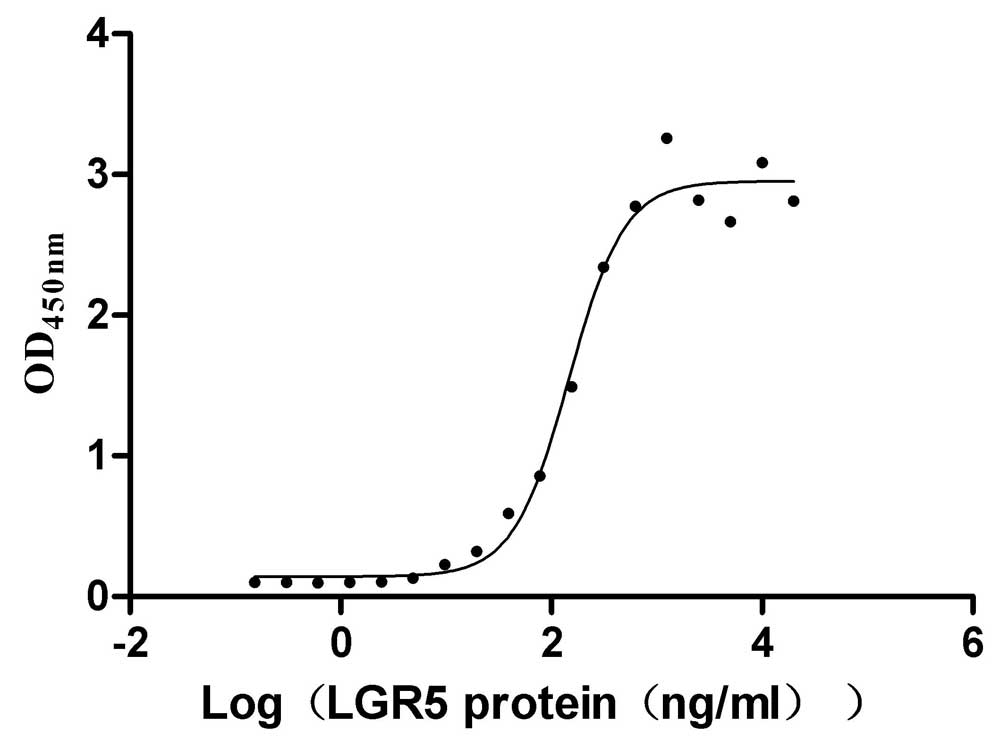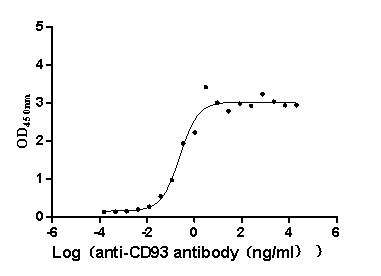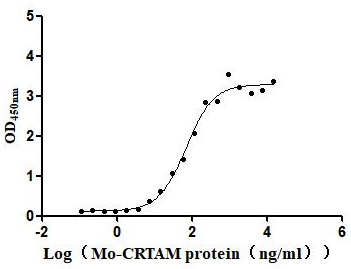Recombinant Cat Natriuretic peptides A (NPPA)
-
中文名稱:Recombinant Cat Natriuretic peptides A(NPPA),Yeast
-
貨號(hào):CSB-YP872386CA
-
規(guī)格:
-
來源:Yeast
-
其他:
-
中文名稱:Recombinant Cat Natriuretic peptides A(NPPA),Yeast
-
貨號(hào):CSB-EP872386CA
-
規(guī)格:
-
來源:E.coli
-
其他:
-
中文名稱:Recombinant Cat Natriuretic peptides A(NPPA),Yeast
-
貨號(hào):CSB-EP872386CA-B
-
規(guī)格:
-
來源:E.coli
-
共軛:Avi-tag Biotinylated
E. coli biotin ligase (BirA) is highly specific in covalently attaching biotin to the 15 amino acid AviTag peptide. This recombinant protein was biotinylated in vivo by AviTag-BirA technology, which method is BriA catalyzes amide linkage between the biotin and the specific lysine of the AviTag.
-
其他:
-
中文名稱:Recombinant Cat Natriuretic peptides A(NPPA),Yeast
-
貨號(hào):CSB-BP872386CA
-
規(guī)格:
-
來源:Baculovirus
-
其他:
-
中文名稱:Recombinant Cat Natriuretic peptides A(NPPA),Yeast
-
貨號(hào):CSB-MP872386CA
-
規(guī)格:
-
來源:Mammalian cell
-
其他:
產(chǎn)品詳情
-
純度:>85% (SDS-PAGE)
-
基因名:
-
Uniprot No.:
-
別名:NPPANatriuretic peptides A; Prepronatriodilatin) [Cleaved into: Atrial natriuretic factor; ANF; Atrial natriuretic peptide; ANP)]
-
種屬:Felis catus (Cat) (Felis silvestris catus)
-
蛋白長(zhǎng)度:Cytoplasmic domain
-
表達(dá)區(qū)域:124-151
-
氨基酸序列SLRRSSC FGGRMDRIGA QSGLGCNSFR Y
-
蛋白標(biāo)簽:Tag?type?will?be?determined?during?the?manufacturing?process.
The tag type will be determined during production process. If you have specified tag type, please tell us and we will develop the specified tag preferentially. -
產(chǎn)品提供形式:Lyophilized powder
Note: We will preferentially ship the format that we have in stock, however, if you have any special requirement for the format, please remark your requirement when placing the order, we will prepare according to your demand. -
復(fù)溶:We recommend that this vial be briefly centrifuged prior to opening to bring the contents to the bottom. Please reconstitute protein in deionized sterile water to a concentration of 0.1-1.0 mg/mL.We recommend to add 5-50% of glycerol (final concentration) and aliquot for long-term storage at -20℃/-80℃. Our default final concentration of glycerol is 50%. Customers could use it as reference.
-
儲(chǔ)存條件:Store at -20°C/-80°C upon receipt, aliquoting is necessary for mutiple use. Avoid repeated freeze-thaw cycles.
-
保質(zhì)期:The shelf life is related to many factors, storage state, buffer ingredients, storage temperature and the stability of the protein itself.
Generally, the shelf life of liquid form is 6 months at -20°C/-80°C. The shelf life of lyophilized form is 12 months at -20°C/-80°C. -
貨期:Delivery time may differ from different purchasing way or location, please kindly consult your local distributors for specific delivery time.Note: All of our proteins are default shipped with normal blue ice packs, if you request to ship with dry ice, please communicate with us in advance and extra fees will be charged.
-
注意事項(xiàng):Repeated freezing and thawing is not recommended. Store working aliquots at 4°C for up to one week.
-
Datasheet :Please contact us to get it.
靶點(diǎn)詳情
-
功能:Hormone that plays a key role in mediating cardio-renal homeostasis, and is involved in vascular remodeling and regulating energy metabolism. Acts by specifically binding and stimulating NPR1 to produce cGMP, which in turn activates effector proteins, such as PRKG1, that drive various biological responses. Regulates vasodilation, natriuresis, diuresis and aldosterone synthesis and is therefore essential for regulating blood pressure, controlling the extracellular fluid volume and maintaining the fluid-electrolyte balance. Also involved in inhibiting cardiac remodeling and cardiac hypertrophy by inducing cardiomyocyte apoptosis and attenuating the growth of cardiomyocytes and fibroblasts. Plays a role in female pregnancy by promoting trophoblast invasion and spiral artery remodeling in uterus, and thus prevents pregnancy-induced hypertension. In adipose tissue, acts in various cGMP- and PKG-dependent pathways to regulate lipid metabolism and energy homeostasis. This includes upregulating lipid metabolism and mitochondrial oxygen utilization by activating the AMP-activated protein kinase (AMPK), and increasing energy expenditure by acting via MAPK11 to promote the UCP1-dependent thermogenesis of brown adipose tissue. Binds the clearance receptor NPR3 which removes the hormone from circulation.; May have a role in cardio-renal homeostasis through regulation of natriuresis, diuresis, vasodilation, and inhibiting aldosterone synthesis. In vitro, promotes the production of cGMP and induces vasodilation. May promote natriuresis, at least in part, by enhancing prostaglandin E2 synthesis resulting in the inhibition of renal Na+-K+-ATPase. However reports on the involvement of this peptide in mammal blood volume and blood pressure homeostasis are conflicting; according to a report, in vivo it is not sufficient to activate cGMP and does not inhibit collecting duct transport nor effect diuresis and natriuresis. Appears to bind to specific receptors that are distinct from the receptors bound by atrial natriuretic peptide and vessel dilator. Possibly enhances protein excretion in urine by decreasing proximal tubular protein reabsorption.; May have a role in cardio-renal homeostasis through regulation of natriuresis, diuresis, and vasodilation. In vitro, promotes the production of cGMP and induces vasodilation. May promote natriuresis, at least in part, by enhancing prostaglandin E2 synthesis resulting in the inhibition of renal Na+-K+-ATPase. However reports on the involvement of this peptide in mammal blood volume and blood pressure homeostasis are conflicting; according to a report it is not sufficient to activate cGMP and does not inhibit collecting duct transport nor effect diuresis and natriuresis. Appears to bind to specific receptors that are distinct from the receptors bound by the atrial natriuretic and long-acting natriuretic peptides. Possibly functions in protein excretion in urine by maintaining the integrity of the proximal tubules and enhancing protein excretion by decreasing proximal tubular protein reabsorption.; May have a role in cardio-renal homeostasis through regulation of diuresis and inhibiting aldosterone synthesis. In vitro, promotes the production of cGMP and induces vasodilation. May promote natriuresis, at least in part, by enhancing prostaglandin E2 synthesis resulting in the inhibition of renal Na+-K+-ATPase. May have a role in potassium excretion but not sodium excretion (natriuresis). Possibly enhances protein excretion in urine by decreasing proximal tubular protein reabsorption.; Hormone produced in the kidneys that appears to be important for maintaining cardio-renal homeostasis. Mediates vasodilation, natriuresis and diuresis primarily in the renal system, in order to maintain the extracellular fluid volume and control the fluid-electrolyte balance. Specifically binds and stimulates cGMP production by renal transmembrane receptors, likely NPR1. Urodilatin not ANP, may be the natriuretic peptide responsible for the regulation of sodium and water homeostasis in the kidney.; May have a role in cardio-renal homeostasis through regulation of natriuresis and vasodilation. In vivo promotes natriuresis and in vitro, vasodilates renal artery strips.; May have a role in cardio-renal homeostasis through regulation of natriuresis and vasodilation. In vivo promotes natriuresis and in vitro, vasodilates renal artery strips.; May have a role in cardio-renal homeostasis through regulation of regulation of natriuresis and vasodilation. In vivo promotes natriuresis. In vitro, vasodilates intestinal smooth muscle but not smooth muscle strips.; May have a role in cardio-renal homeostasis through regulation of natriuresis and vasodilation. In vivo promotes natriuresis. In vitro, selectively vasodilates intestinal and vascular smooth muscle strips.; May have a role in cardio-renal homeostasis through regulation of natriuresis and vasodilation. In vivo promotes natriuresis. In vitro, selectively vasodilates intestinal smooth muscle but not vascular smooth muscle strips.
-
亞細(xì)胞定位:[Long-acting natriuretic peptide]: Secreted.; [Vessel dilator]: Secreted.; [Kaliuretic peptide]: Secreted.; [Urodilatin]: Secreted.; [Atrial natriuretic peptide]: Secreted. Perikaryon. Cell projection.; [Atriopeptin-3]: Secreted.
-
蛋白家族:Natriuretic peptide family
-
數(shù)據(jù)庫(kù)鏈接:
KEGG: fca:101100575
STRING: 9685.ENSFCAP00000000063
Most popular with customers
-
Recombinant Human Tumor necrosis factor ligand superfamily member 8 (TNFSF8), partial (Active)
Express system: Mammalian cell
Species: Homo sapiens (Human)
-
Recombinant Human Claudin-18.2 (CLDN18.2)-VLPs (Active)
Express system: Mammalian cell
Species: Homo sapiens (Human)
-
Recombinant Human R-spondin-1 (RSPO1), partial (Active)
Express system: Mammalian cell
Species: Homo sapiens (Human)
-
Recombinant Human Angiopoietin-2 (ANGPT2) (Active)
Express system: Mammalian cell
Species: Homo sapiens (Human)
-
Recombinant Macaca fascicularis CD93 molecule (CD93), partial (Active)
Express system: Mammalian cell
Species: Macaca fascicularis (Crab-eating macaque) (Cynomolgus monkey)
-
Recombinant Human C-C chemokine receptor type 8 (CCR8)-VLPs (Active)
Express system: Mammalian cell
Species: Homo sapiens (Human)
-
Recombinant Mouse Cell adhesion molecule 1 (Cadm1), partial (Active)
Express system: Mammalian cell
Species: Mus musculus (Mouse)
-
Recombinant Human Cell adhesion molecule 1 (CADM1), partial (Active)
Express system: Mammalian cell
Species: Homo sapiens (Human)



-AC1.jpg)

-AC1.jpg)














